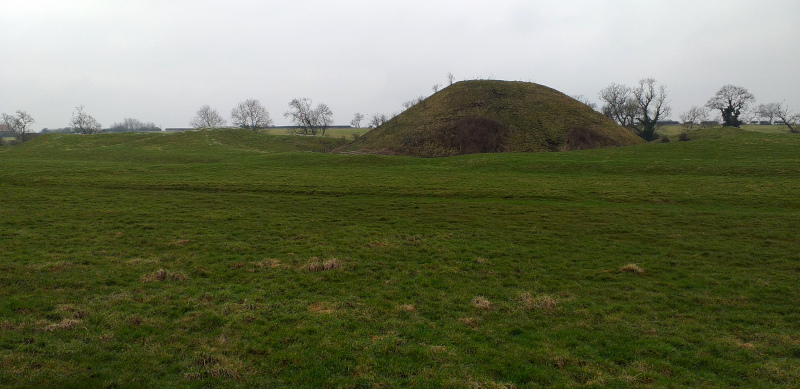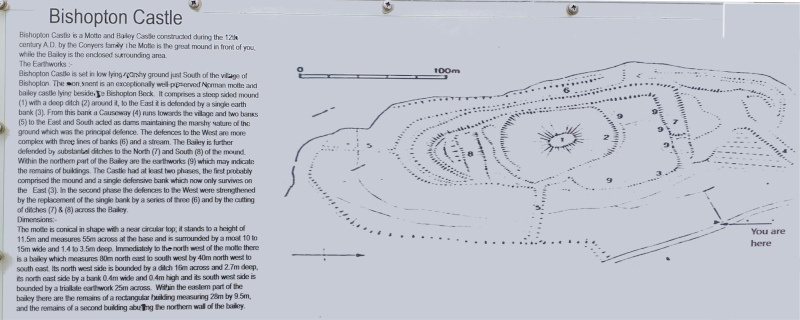If you ever pass through the town of Bishopton, you may notice a small hill in a field next to the road. It’s easy to see the hill is man-made and you can be forgiven if you mistake it for a burial mound. I certainly did. I was wrong. That hill on the outskirts of Bishopton is not a burial mound.
If you walk over to the stile that allows pedestrians to access the field, you will find a small information board that states you are looking at Bishopton Castle.
This revelation is surprising because “Bishopton Castle” is clearly nothing more than a hill. There are no structures on the hill at all. Nor are there any castle ruins so to call it a castle is an overly grand claim. However, some people refer to the site as Castle Hill. There used to be a small castle there, so that’s a better name.
The history of Bishopton Castle and Castle Hill is quite interesting and, although the castle is long gone, the intricate earthworks remain. If you spend a little time exploring the site, you should be able to gain an understanding of the clever system that made it possible to divert water from Bishopton Beck and use it as a defence mechanism.

History of Castle Hill
The hill that used to sit beneath Bishopton Castle is about 11.5 meters (38 ft) tall and measures 55 meters (180 ft) across its base. However, when it was constructed, during Norman times (1066 – 1075), the hill was 18 meters (60 ft) high. Its diminished size is the result of nearly 900 years of soil erosion.
Bishopton Castle was (is?) a motte and bailey castle and even though the castle is no longer there, the site has great historic significance and is considered one of the best-preserved motte and bailey castles in the UK.
Early motte and bailey castles were always made of wood. The exclusive use of wood made them quick and easy to erect. Motte and bailey castles counteracted from 1100 onward were generally made from stone. They took longer to build but had the advantage of being stronger and less susceptible to attack by fire.
Bishopton Castle was an early type, made from wood, so it’s not surprising none of the structure remains.
As the name suggests, motte and bailey castles consist of a motte and a bailey.
The word “motte” refers to the large conical mound of earth. The mounds were generally built by hand using a combination of earth and rubble. The top area had a tall tower enclosed in a palisade. The high vantage point made it easier for bowmen in the tower to pick-off enemies trying to attack.
Most motte and bailey castles also had an embanked courtyard below them containing additional buildings protected by another palisade. This was known as the “bailey.”
One of the most interesting things about Bishopton Castle is it had two baileys instead of one. It also had a couple of large enclosures beyond the baileys. Even if enemies managed to gain access to the baileys, attempts to advance further would have been hindered by the moat that surrounded the motte.
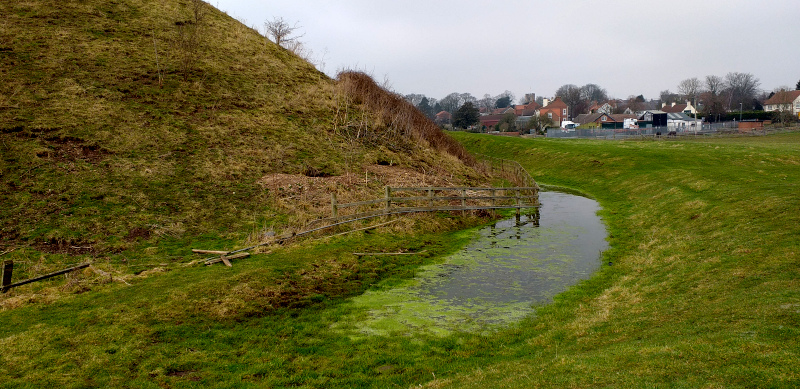
There are few grey areas regarding the history of Bishopton Castle but it’s generally believed it was constructed in 1143 by Roger de Conyers during a feud with the usurper William Cumin.
It was a troubled time. King David of Scotland had already invaded Northumberland and had plans to take control of the whole of North-East England. A key player in the invasion, Cummins tried to install himself as Bishop of Durham.
Roger de Conyers fortified his manor house at Bishopton and led the resistance. His home successfully withstood an attack in the summer of 1143. The history is a little unclear but Bishopton Castle appears to have been constructed around this time and eventually became the property of the true Bishop of Durham. (Further Reading: William Cummin: Border Politics and the Bishopric of Durham 1141 – 1144)
Monument Details and What to Expect
If you decide to explore the former site of Bishopton Castle, don’t expect to find lots of interesting old ruins. But do take advantage of the opportunity to examine the terrain and take the time to look at the information board at the edge of the field. It will make it easier to understand the things that you see.
How to Find Bishopton Castle/Castle Hill
Unless you have access to a car or a bike, getting to Bishopton is going to be a problem. The town is no longer covered by a bus service. The Stagecarriage M8 bus used to link Bishopton with Stockton but the company axed the service in 2016, after the loss of council subsidies.
Getting a taxi from Darlington or Stockton is easy enough but the journey will probably cost around £10 –£20 each way, depending on which service you choose.
If you are willing to cycle to Bishopton, the journey from Darlington or Stockton should take 35 – 45 minutes. Traffic permitting, the journey is only about 15 minutes if you travel by car. (Click Here to Get Directions)
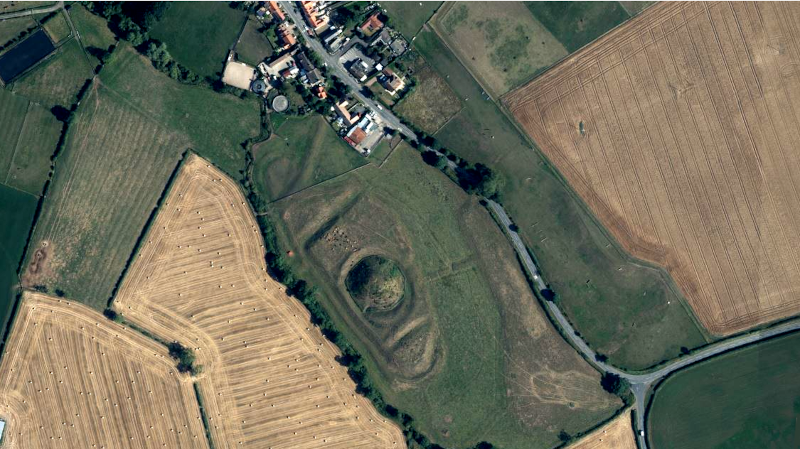
Things to Know Before You Go
Although it may not be apparent when you are stood looking at the hill, the field that surrounds Bishopton Castle Hill is often quite wet and boggy. That probably won’t be a problem if you are wearing wellington boots but, if you are not, it’s easy to find yourself walking around with wet feet.
If you want to avoid the wet ground, the best thing to do is start walking left as soon as you enter the field and stick to the higher ground. Due to the slant of the field, it may not look higher but the difference is usually enough to stop your feet from getting wet.
When you reach the earth bank (no. 5 on the plan above), head towards the hill and then follow the narrower bank (no.3 on the plan) and try to find a dry-looking route to access the hill.
It’s probably best to take a clockwise route and try and access the hill from the side instead of the front. The moat at the front of the hill is more likely to contain water. There is also a small wooden fence that will get in your way.
Needless to say, if there has been a lot of heavy rain, it may be a good idea to postpone your visit to Castle Hill until a dryer day.
Regardless of the weather, if you plan to climb to the top of Castle Hill, it’s probably a good idea to wear some footwear with good grips on the sole. It’s a pretty steep climb. If your soles are not up to the job, it would be easy to slip and find yourself at the bottom of the hill with a few scuffs and bruises and, possibly, some tears in your clothes.
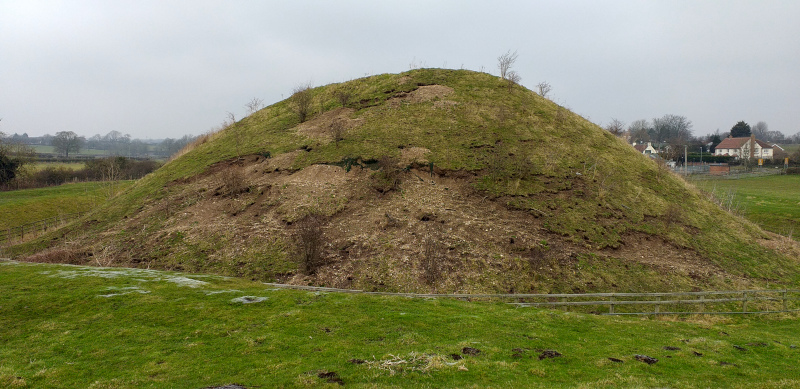
On the plus side of things, the hill appears to be very popular with rabbits, so there are plenty of rabbit holes you can take advantage of if you are looking for a better foothold.
– – – – –
– – –
– – –
– – – – –
